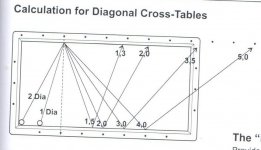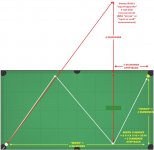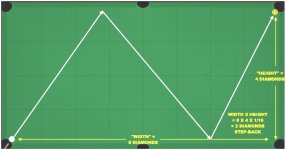You are using an out of date browser. It may not display this or other websites correctly.
You should upgrade or use an alternative browser.
You should upgrade or use an alternative browser.
The "Z" kick
- Thread starter Aaron_S
- Start date
One rail kick- take the distance from the ob to the rail. To do this, just place your tip at the ball, and mark the cue with your finger where it touches the rail. Bring the cue straight back so that now the tip is touching the rail. Keeping your cue straight, look down the line from your finger on the cue to the cb. Where that line crosses the rail is where you want to hit the rail with the cb.
thanks for your reply:thumbup:
im happy that i already use that "mirror system"
Neil, you're simply using the "mirror" method to find the "equal-angle" 1st rail target for hitting the same 2nd rail target I calculated. Is that really the way Reid says to do it? I don't remember that part.Pat, you aren't understanding it correctly. The system does not show the second rail target point, but the first rail target point. Your "step back" is done wrong. Re-read what I wrote above.
You've got it right that the adjustment is two diamonds, but you did it wrong. At this point, you should be standing behind the one at the top of the diagram you made. You now take the width of the table, and adjust over two diamonds from the one. That gives you 3 1/4 diamonds as your first rail target.
You take your cue, and find the width of the table with it and mark that spot with your finger. You then go behind the one, adjust your two diamonds over, and place your tip at the rail. You then look down the line from where your finger is on the cue to the cb. Where that line crosses the rail is where your first rail target is.
Anyway, the mirror method is an OK way to get the equal-angle 1st rail reference target, as long as you remember to adjust from that equal-angle target for ball/cloth/speed/spin conditions.
The mirror-image 1st rail target for this shot should be 3 diamonds measured at the cushion nose (half the distance to the 2nd rail target at 6 diamonds) - maybe you're measuring to the top of the rail to get 3 1/4? On most tables you'll need to adjust your aim a little shorter (as I show) in order to hit the 2nd rail target at 6 diamonds.
pj
chgo
Last edited:
I don't know how you mean it's different. The "equal-opposite" measurement you describe is the well known "mirror" method, which is also the one-rail version of the "spot-on-the-wall" method. These are all the same common method of measuring one-rail kicks - it's probably most familiar for shallow rail-first shots along the rail.Neil:
I don't know if you know how to do a one rail kick using the equal-opposite method he teaches. But, this is a little different, yet similar.
What this method measures is simply the equal-angle track to hit the spot opposite the spot on the rail you're measuring from.
pj
chgo
Last edited:
I didn't read this entire thread. Probably mentioned but the 2nd rail return line varies with the condition of the equipment. New clean cloth and new balls you will see some slide off the second rail. Also any reverse off the 1st rail will continue and be running off the 2nd. Running or no English off the 1st rail will continue and be reverse off the 2nd. These just need to be done carefully with a nice smooth quiet stroke.
Here's the returns from Dr. Gerhard Hupper's book "Billiards Manual" Three Cushion. Of course remember pool tables usually play short compared to a 3C table. So play the marks on a specific table and note the differences and adjust. Then you'll be able to adjust to any table.

Here's the returns from Dr. Gerhard Hupper's book "Billiards Manual" Three Cushion. Of course remember pool tables usually play short compared to a 3C table. So play the marks on a specific table and note the differences and adjust. Then you'll be able to adjust to any table.

I think we pretty much agree. We agree on how to calculate the adjustment for Reid's system, we even agree on where the 1st rail equal-angle target is. All we see differently is what role the "equal-opposite" measurement plays.Like I said earlier Pat, you have your head so stuck on what you think it is that you can't see what it really is.
You can either argue what you think it is, or you can take it to a table and actually learn something. Your choice. But, I'm not going to sit here and argue about it with you. You can either learn something, or not, I don't really care. It's up to you what you want to do.
To show how much we agree, here's my version and yours (in red) compared for the same shot:

You can see they produce exactly the same results. It seems clear to me that the equal-opposite measurement is not part of the adjustment calculation but just a typical 1-rail kick measurement to hit the calculated 2nd rail target - Reid says so in his video if you listen carefully.
Regardless, we can differ on that while still admiring Reid's innovative way of calculating the adjustment.
pj
chgo
Last edited:
if the object ball was on the 3rd diamond
would you use 3 or 4 diamonds as the equal opposite??
if i understand it correct the step back would be 1 1/2 from the object ball
for the cue ball in the corner pocket and the object ball 3 diamonds distance on the foot rail(instead of 4 if it where in the diagonal pocket)
would you use 3 or 4 diamonds as the equal opposite??
if i understand it correct the step back would be 1 1/2 from the object ball
for the cue ball in the corner pocket and the object ball 3 diamonds distance on the foot rail(instead of 4 if it where in the diagonal pocket)
Last edited:
Pat, go watch the video clip again. What I described is exactly the same way Jimmy shows it. For that matter, if you just follow the directions, and use your diagram, and take a sheet of paper up against your screen as your cue stick, you will see that it comes out to 3 1/4 diamonds for your hit on the first rail. And, I have also shot this in real life and have great success at it. So, it does work as described.
Going by what you just said, it sounds like you have your head stuck on what you think is the way to do it, and aren't being open to how it is actually figured out. You aren't understanding how to do it yet.
I don't know if you know how to do a one rail kick using the equal-opposite method he teaches. But, this is a little different, yet similar. I'll describe it once more-
Take your cue and find the width of the table with it, and mark it with your finger. Do your calculations to find the adjustment amount. In this case, the adjustment is two diamonds. Now go over two diamonds from the diamond the one is at. Take your cue and put the tip at the rail at that point. Now, just look down your cue from where your finger is at on the cue (the width of the table mark you found earlier) to the cb. Where that line crosses the rail is your target point to hit the cb to.
Your mark on the cue is always the width of the table. It doesn't matter on the Z kick where the ob ball is because your adjustment takes that into consideration, not your mark on the cue.
thanks for answering my question...:thumbup:
i need to pay more attention ...:embarrassed2:
without running english the ball goes short ???
i need to hit 2 1/2 2 3/4 to make it
running english would go even shorter???
i should have quoted you above in my postOk, so you are doing the calculation differently - wow, I certainly didn't get that from the video. That does move the aim point a half a diamond in the right direction, but is still 1/2 to 3/4 of a diamond longer than I usually aim for this shot. As you say speed and spin are huge, as with all kicks, and I usually play my shot slightly above center, no side spin, and pocket speed. I know that there is a spin speed combo that will allow me to hit 3/4 of a dot longer than usual, although I'm sure if I put any running english at all on it I will have to shorten it with draw, which would be senseless overuse of spin. I'm hoping a hard center ball hit will do it, as I have a strong aversion to kicking systems that require side spin when a simple speed adjustment will produce the same effect much more predictably. I will experiment tonight and report back.
Thanks,
Aaron
i have the same issues as you
you can post or pm me if you figure out the discrepanvy
You always use 4 diamonds to measure the equal-opposite, no matter how far from the rail the OB is.if the object ball was on the 3rd diamond
would you use 3 or 4 diamonds as the equal opposite??
if i understand it correct the step back would be 1 1/2 from the object ball
for the cue ball in the corner pocket and the object ball 3 diamonds distance on the foot rail(instead of 4 if it where in the diagonal pocket)
The equal-opposite measurement is not part of the step-back calculation; it's just a way to aim the 1-rail kick so it will hit the calculated 2nd rail target.
pj
chgo
Running English makes any kick go longer....running english would go even shorter???
pj
chgo
Running English makes any kick go longer.
pj
chgo
thanks for the reply above post#58
you are correct
i was thinking that with running english instead of hitting the object ball at the 4th diamond the cue ended up at the 2nd diamond on the foot rail
that really is longer not shorter even though 2 is less(shorter) than 4...:grin:
The video was a little hard for me to follow when I first saw it too - I even drew a diagram to help me decipher it. I understand it the same way Neil does.
A quick way to think of the math is width x height x 1/16 (CB-OB lateral distance x rail-OB vertical distance x 1/16).
View attachment 226117
pj
chgo
Thank you Patrick, that makes a TON of more sense!!!
